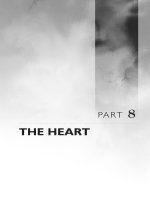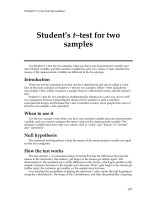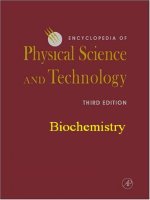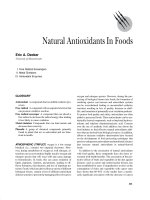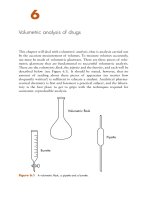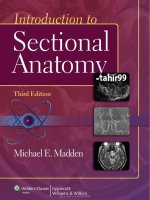Ebook Surface and radiological anatomy (3rd edition): Part 1
Bạn đang xem bản rút gọn của tài liệu. Xem và tải ngay bản đầy đủ của tài liệu tại đây (11.17 MB, 98 trang )
Surface and
Radiological
ANATOMY
Third Edition
A. Halim
Other CBS books in Anatomy
Surface and
Radiological
ANATOMY
THIRD
EDITION
Surface and
Radiological
ANATOMY
THIRD
A. Halim
EDITION
MBBS M S F I M S A
Ex-head and Professor of Anafomy
King George's Medical College
Lucknow Universify
WHO Fellow in Medical Education (UK)
Fellow British Association of Clinical Anatomists
Ex-member Academic Council, King George's
Medical and Dental Universities
Lucknow India
CBS
CBS Publishers & Distributors pvt Ltd
New Delhi • Bengaluru • Pune • Kochi • Chennai
Mumbai • Kolkata • Hyderabad • Patna • Manipal
Disclaimer
Science and technology are constantly changing fields. New
research and experience broaden the scope of information and
knowledge. The author has tried his best in giving information
available to him while preparing the material for this edition of
the book. Although, all efforts have been m a d e t o ensure
optimum accuracy of the material, yet it is quite possible some
errors might have been left uncorrected. The publisher, printer
and the author will not be held responsible for any inadvertent
errors or Inaccuracies.
Surface and
Radiological
ANATOMY
Third Edition
ISBN: 978-81-239-1952-2
Copyright © Author and Publishers
Third Edition: 2011
Reprint: 2013
First Edition: 1988
Second Edition: 1993
All rights reserved. No part of this book may be reproduced or transmitted in any form or
by any means, electronic or mechanical, including photocopying, recording, or any
information storage and retrieval system without permission, in writing, from the author
and the publisher.
Published by Satish Kumar Jain for
CBS Publishers & Distributors Pvt Ltd
4819/XI Prahlad Street, 24 Ansari Road, Daryaganj, New Delhi 110 002, India.
Ph: 23289259, 23266861, 23266867
Fax:011-23243014
WebSite: www.cbspd.com
e-mail: :
Corporate
Office:
204 FIE, Industrial Area, Patparganj, Delhi 110 092
Ph: 4934 4934
Fax: 4934 4935
e-mail: :
Branches
•
Bengaluru: Seema House 2975, 1 7th Cross, K.R. Road,
Banasankari 2nd Stage, Bengaluru 560 070, Karnataka
Ph: .91-80-26771678/79
•
Fax:+91-80-26771680
e-mail:
Pune; Bhuruk Prestige, Sr. No. 52/12/2 + 1 + 3 / 2 Narhe, Haveli
(Near Katraj-Dehu Road Bypass), P u n e 4 i i 041, Maharashtra
Ph: +91-20-64704058, 64704059, 32342277
•
Fax:+91-20-24300160
e-moil:
Kochi: 36/14 Kalluvilakam, Lissie Hospital Road, Kochi 682 ois, Kerala
Ph: +91-484-4059061-65
Fax: +91-484-4059065
e-mail:
• C h e n n a i 20, West Park Road, Shenoy Nagar, Chennai 600030, Tamil Nadu
Ph. (91-44-26260666,26208620
Fax:+91-44-42032115
e-mail:
Representatives
•
M u m b a i 0-9833017933
• Kolkata
•
Patna
• M a n i p a l 0-9742022075
Printed
0-9334159340
at
0-9831437309
M a g i c i n t e r n a t i o n a l Pvt. Ltd, G r e a t e r
• Hyderabad
Noida
0-9885175004
to
my s t u d e n t s
"A teacher affects eternity,
he can never tell where his influence stops"
— Henry Brooks Adams
Preface to the Third Edition
I
n preparing the third edition of this book which has been well received for
almost over two decades, I have retained the earlier version for its easy approach
to the subject. The diagrams of surface anatomy in Part I have been coloured
since colour captures a reality that is more consistent with the mode of learning
and has become an increasingly important element for most of the students today.
Apart from this, instead of abbreviated labelling full labelling of the figures has
been done for better understanding.
In Part II the radiographs by repeated printing had become indistinct and have
been mostly replaced by photographs of digital X-ray plates for their clarity. New
ultrasonographs, computerised axial tomographs and MRI photographs have
been put in.
The new imaging techniques have replaced contrast radiographic techniques
like bronchography and cholecystography. Ultrasonography of hepatobiliary
system, for example, is more sensitive than cholecystography in detecting small
stones and biliary sludge and moreover the patients are not exposed to radiation.
Contrast radiographs have their anatomical value to the student so chapters
dealing with these have been retained.
I hope that the changes which have been made will facilitate the understanding
of the text.
A. Halim
Acknowledgements
I
wish to acknowledge my thanks to many of my colleagues whose criticism
and advice guided me in preparing this book. I am grateful to Prof GN Agarwal,
Head of the Department of Radiology, King George's Medical College, Lucknow,
who very kindly provided most of the radiographs. The radiographs in the chapter
on bone age estimation and ossification of limb bones were acquired from the
department of anatomy, King George's Medical College and were due to research
work done by Prof Mahadi Hasan and Prof ID Bajaj for their MS theses. I am
thankful to them for allowing me to use these radiographs in my book.
I wish to express my appreciation of the many laborious hours spent by the
artist Mr GC Das for successfully executing the illustrations and for carefully
reproducing the tracings of the radiographs. The photographic prints were made
by Mr. VP Srivastava, Chief Technical Officer, Central Photographic Section, King
George's Medical College, Lucknow. I am thankful to Mr RS Saxena, of the
Department of Anatomy, KGMC, for the careful typing and retyping of the script.
I will be failing badly if I do not mention the encouragement which I received
from my wife and my children in writing the book which has been a unique
experience for the preparation of this edition.
For this revised edition I am most grateful to Dr Ratan Kumar Singh of Charak
Diagnostic and Research Centre, Lucknow, for providing me digital radiographs.
I am much indebted to Prof Ragini Singh, Head Department of Radiodiagnosis,
and Prof Naseem Jamal, Head Department of Radiotherapy, CSM Medical
University, for giving me CT photographs and USG strips.
I wish to thank Mr Ravi Kapoor, a famous photographer of Lucknow, for
preparing photographic prints of the new radiographs. I also extend my most
sincere appreciate to Mr Majumdar, the artist, for his careful tracings of the new
radiographs.
Finally, I wish to express my gratitude to Mr SK Jain, Managing Director,
Mr YN Arjuna, Senior Director—Publishing, Editorial and Publicity, and the
editorial staff of CBS Publishers and Distributors, New Delhi, for their great
assistance in the preparation of the third edition.
A. Halim
Preface to the First Edition
S
urface and radiological anatomy form an important subdivision of anatomy.
When a patient is examined it is his anatomy which is being examined.
Surface anatomy is the study of deeper parts in relation to the skin surface. A
mental picture of surface anatomy is needed by every doctor during the physical
examination of a case whether it is by inspection, palpation, percussion or
auscultation.
Radiological anatomy is the study of deeper organs by plain or contrast
radiography. Diagnostic radiology is one of the most widely used investigation.
Knowledge of the normal radiological appearances is indispensable as a
background for the proper interpretation of radiographs for clinical purposes.
There has been a pressing need for a handy book on surface and radiological
anatomy for students preparing for their examinations in this basic medical
subject, hence this humble attempt on my part. Each statement included in this
book has been drawn from the best known anatomy, radiology, medicine and
surgery textbooks to make it authentic.
The book has been arranged in two sections. In the first section on surface
anatomy it has been my endeavour to give in a systematic manner the marks
which have to be put in outlining a particular structure so that the student does
not have to search out the surface projection data from continuously written
paragraphs as is usual in other books available on the subject. The structures
intended for surface marking have been arranged in alphabetical order in
subsections on arteries, veins, nerves, glands, viscera, joints, etc. to make them
easy for reference.
The second section deals with radiological anatomy. The value of X-rays for the
study of anatomy need not be stressed. It has been the aim to organise and to set
down as concisely as possible w h a t are considered basic facts of normal
radiographic anatomy. Radiographs of different regions of the body in standard
positions have been given with well elucidated parallel line diagrams and
elaborate descriptions. The third chapter in this section has been specially written
for the purpose of bone age estimation. Line diagrams depicting the sequence of
ossification of union in different regions have been specially prepared to help
student in assessing the bone age. A large number of radiographs of different
age groups have been added to give the student an exercise on age determination
on the basis of sequence of ossification and union in that region. Three tables to
help the student better have been compiled.
Techniques of radiological procedures are described particularly those dealing
with the more complicated diagnostic procedures such as bronchography.
x
Surface and Radiological Anatomy
The care of the subject before and after such investigations has also been given as
the student should have some idea of what the examination entails and the way
it is conducted.
There is a separate chapter on angiography which is one of the more specialised
area of diagnostic radiology. Aortography and cerebral angiography has been
dealt with in some detail. Some of the more advanced techniques are out of the
scope of this elementary book and hence have been left out.
At the end a chapter on the new imaging devices has been added to give the
student some idea of these body-scanning techniques which have revolutionised
diagnostic medicine in the past two decades.
A. Halim
Contents
Preface to the Third edition
Preface to the First edition
vii
ix
Part I: SURFACE ANATOMY
SUPERIOR EXTREMITY
5
INFERIOR EXTREMITY
22
THORAX
36
ABDOMEN A N D PELVIS
49
HEAD A N D NECK
65
BRAIN
81
Part II: RADIOLOGICAL ANATOMY
SUPERIOR EXTREMITY
91
INFERIOR EXTREMITY
97
BONE AGE
105
THORAX
136
ABDOMEN A N D PELVIS
153
HEAD A N D NECK
177
VERTEBRAL C O L U M N
182
ANGIOGRAPHY
189
NEW I M A G I N G DEVICES
195
Index
207
Surface Anatomy
SUPERIOR EXTREMITY
INFERIOR EXTREMITY
THORAX
ABDOMEN AND PELVIS
HEAD AND NECK
BRAIN
NOTES
m
M Introduction
The surface anatomy deals with the study of position of structures in relationship
to the skin surface of the body. It helps in exploring these structures from the surface
wherever necessary. Bony, muscular and other landmarks on the surface of the
body are taken as guides. The landmarks may be visible or palpable.
1. Visible landmarks can be seen on inspection as they produce irregularities in the
surface outline of the body. Majority of them are produced by bones or cartilages.
Nipple and umbilicus also fall in this category.
2. Palpable landmarks are felt through the skin. Muscles and tendons become palpable
by being put into contraction, arteries by their pulsations and nerves by rolling
against bones. Spermatic cord and parotid duct can also be felt through the skin.
Important visible and palpable landmarks have been described and indicated in
diagrams. While drawing the surface marking of a particular structure, the student
is advised to put the required points first and then to join these by various lines as
instructed.
3
Superior Extremity
SHOULDER, AXILLA, ARM A N D ELBOW REGIONS
SURFACE LANDMARKS (Anterior Aspect) (Fig, 1.1)
t) Anterior axillary fold is formed by the rounded lower border of pectoralis major.
It becomes prominent when the abducted arm is adducted against resistance.
y Clavicular head of pectoralis major can be recognised as it contracts when the
arm is flexed to a right angle.
Q Coracoid process points almost straight forward, 2.5 cm vertically below the
junction of the lateral fourth and medial three-fourths of the clavicle. Anterior
fibres of deltoid cover it.
Coracoid process
Tip of acromion
Sternal angle
Greater tuberosity
Lesser tuberosity
Deltoid
Anterior axillary fold
Medial epicondyle
Biceps tendon
Fig. 1.1: S u r f a c e l a n d m a r k s — s h o u l d e r , axilla, a r m a n d e l b o w r e g i o n s ( a n t e r i o r a s p e c t )
5
6
j Surface Anatomy
D Deltoid insertion can be identified when the arm is maintained in the abducted
position. It is half a way down the lateral aspect of humerus. Its anterior border
can also be easily seen.
O Greater tuberosity of humerus is the most lateral bony point in the shoulder
region.
Q Lateral epicondyle of humerus is readily recognisable from the posterior aspect
in the upper part of a well marked depression situated on the lateral side of the
middle line.
V) Lesser tuberosity of humerus lies 3 cm below the tip of the acromion on the
anterior aspect of the shoulder.
O Medial epicondyle of humerous is a conspicuous landmark felt easily on the
medial side in a flexed elbow.
Q Sternal angle (angle of Louis) can be easily felt as a ridge by running the finger
downwards on the sternum from the suprasternal notch. Traced laterally it leads
to second costal cartilage. The ribs can be counted downwards after the second
rib has been located.
( j Tendon of biceps becomes prominent when the elbow is flexed, it can be grasped
in the cubital fossa.
Q Tip of acromion is situated lateral to the acromioclavicular joint and can be
easily felt.
SURFACE LANDMARKS (Posterior Aspect) (Fig. 1.2)
Si Acromial angle: Lower border of the crest of the spine becomes continues with
the lateral border of the acromion at this angle.
Spines
U c1
- Acromial angle
- Greater tuberosity
- Crest of scapular spine
Wt3
- Inferior angle of scapula
U t7
- Lateral epicondyle
- Tip of olecranon
- Head of radius
Fig. 1.2: Surface landmarks—shoulder, axilla, arm and elbow regions (posterior aspect)
Superior Extremity
7
y Apex of the olecranon can be felt well to the inner side of the mid-point of the
inter-epicondylar line in an extended elbow. The tip of the olecranon and the
two epicondyles form an isosceles triangle when the elbow is flexed.
Q Crest of the scapular spine is subcutaneous throughout. It runs downwards
and medially to reach the medial border of the bone opposite the third thoracic
spine.
Q Head of the radius is situated below the lateral epicondyle in the depression
described above, Tying in the valley behind the supinator longus (biceps)'
(Holden). It can be felt to rotate when the forearm is alternately pronated and
supinated.
Q Inferior angle of scapula can be felt at the level of the seventh thoracic spine
when the medial border of scapula is traced downwards.
y Posterior surface of the olecranon is subcutaneous and tapers from above
downwards.
Q Triceps, lateral head lies parallel to the posterior border of the deltoid. To its
medial side is the long head of triceps.
SURFACE MARKINGS
Gland
Breast (Fig. 1.3)
•
•
•
Put a mark at the margin of the sternum opposite the sternal angle.
Mark the sternal end of the sixth costal cartilage.
Draw the midaxillary line.
Axillary artery
Second rib
Sternal angle
Midaxillary line
Anterior axillary fold
Sixth rib
Fig. 1.3: Breast and axillary artery
8 ./ Surface Anatomy
•
Put a mark on the pulsation of the axillary artery under cover of anterior axillary
fold.
• Mark the second rib and cartilage.
The breast can now be indicated by drawing a circular line passing through these
various points but going u p w a r d s into the axilla u p to the axillary vessels to mark
the tail of Spence.
JOINTS
The Elbow Joint
On the front the plane of the joint can be represented as follows (Fig. 1.4a).
• Put a point 2 cm below the medial epicondyle.
• Mark a point 2 cm below the lateral epicondyle.
Join these points by a line directed downwards and medially. The line is oblique
because of the carrying angle and also represents the distal limit of the cavity of the
joint.
The proximal limit of the joint cavity c a n b e r e p r e s e n t e d o n t h e f r o n t of t h e a r m b y
the following line (Fig. 1.4b).
• Put a point just above the tubercle on the coronoid process.
• Mark a point over the most lateral part of the front of the medial epicondyle.
• Mark the level of the head of the radius.
• Draw a curved line from the first point arching across to the last point
Humerus
Humerus
Lateral
epicondyle
'Media' ,
epicondyle
Lateral •
epicondyle
Medial
epicondyle
Coronoid
process
of ulna
Head of radius
(a)
(b)
Figs 1.4a a n d b:
Elbow joint (front)
On the back the plane of the elbow joint can be represented as follows (Fig. 1.5a).
• Put a point in the depression between the head of the radius and the lateral
epicondyle.
• Mark the tubercle on the medial border of the coronoid process.
Join these points by a line which also represents the distal limit of the joint cavity.
Superior Extremity
|
9
The proximal limit of the joint cavity can be represented on the back of the elbow
as follows (Fig. 1.5b).
• Mark a point in the depression between the head of the radius and the lateral
epicondyle.
• Put a point on the tubercle, on the medial border of the coronoid process.
Draw a line from the first to the second point by an arch a little wide of the
outline of the olecranon process.
Humerus
Humerus Lateral
epicondyle
Lateral
epicondyle
Head of radius
Tubercle of coronoid
process of
ulna
Head of radius
Tubercle ofcoronoid
process of
ulna
(a)
(b)
Figs 1.5a a n d b : E l b o w j o i n t ( b a c k )
Shoulder Joint
The joint line can be represented on the front as follows (Fig. 1.9):
• Put a point on the coracoid process.
Draw a line downwards from the above point.
• The joint line can be represented on the back as follows (Fig. 1.7):
• Put a point on the acromial angle.
Draw a line downwards from the above located point.
NERVES
Axillary Nerve (Fig. 1.7)
•
•
Mark the mid point of the line joining the tip of acromion to the deltoid tuberosity.
Put a point 2 cm above the mid point of the above line. Draw a transverse line
from the second point across the deltoid muscle.
Median Nerve (Fig. 1.6)
Draw the brachial artery (page 11)
The nerve is marked lateral to the artery in upper half and medial to it in the
lower half crossing the front of the vessel in the middle.
•
10
Surface Anatomy
Musculocutaneous Nerve (Fig. 1.6)
•
•
•
•
Put a point 5 cm below the coracoid process.
Mark the mid-point of the elevation caused by the biceps.
Put a point lateral to the tendon of biceps.
Join these points to get its surface marking.
Radial Nerve (Figs 1.6 a n d 1.7)
•
•
Mark the commencement of the brachial artery.
Join the insertion of the deltoid to the lateral epicondyle. Put a mark on the
junction of the upper and middle-third of this line.
• Put a mark at the level of lateral epicondyle 1 cm lateral to the tendon of biceps.
These points should be joined by a line crossing the elevation produced by long
and lateral heads of triceps.
Radial nerve
Musculocutaneous nerve
- Coracoid process
Biceps tendon-
Median nerve
Ulnar nerve
Brachial artery
Fig. 1.6: Nerves in the front of arm
Acromial angle
Axillary nerve
Deltoid insertion
.ateral epicondyle of humerus
tfledial epicondyle of humerus
Radial nerve
Ulnar nerve
Fig. 1.7: Nerves in the back of arm
Superior Extremity |
11
Ulnar Nerve (Fig. 1,6)
•
•
•
Put a point at the commencement of the brachial artery by feeling its pulsation.
Mark the mid-point of the brachial artery.
Put a mark on the ulnar nerve on the back of the medial epicondyle by rolling
it.
Draw a line following the medial side of the brachial artery half-way down its
course. The line should then diverge to join the point on the back of medial
epicondyle.
SSI
VESSELS
ARTERIES
Axillary Artery (Fig. 1.3)
Abduct the arm to a right angle.
• Mark the mid-point of clavicle.
• Put a point on the pulsation of the lower part of the axillary artery at the junction
of the anterior and middle thirds of the outer axillary wall at the outlet of that
space and just in front of the posterior axillary fold which becomes prominent
when the abducted arm is adducted against resistance.
Join these points by a broad line.
Brachial Artery (Fig. 1.8)
•
Put a point on the pulsation of the lower part of axillary artery on the medial
side of the arm, just in front of the posterior axillary fold.
• Mark a point at the level of the neck of the radius in the middle line of the limb.
Join these points to get the surface marking.
Axillary artery
Brachial arterv
Fig. 1.8: Brachial artery
Clavicle

